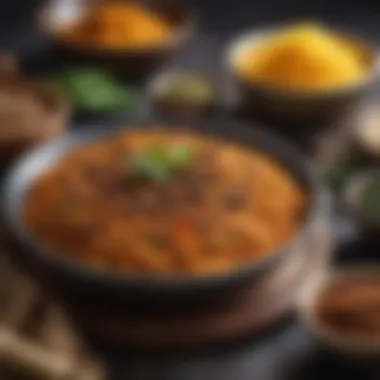Exploring Cumin: A Spice's Role in Global Cuisine


Intro
Cumin is a spice that is integral to culinary traditions around the world. It is not just a flavor enhancer; it embodies a rich history and cultural importance. As a staple in a variety of cuisines, cumin bridges dietary practices across continents. This article aims to uncover the diverse applications of cumin, its health benefits, and its historical relevance. By exploring these aspects, we hope to enhance the understanding and appreciation of cumin in modern cooking.
Recipe Overview
Cumin is often found in dishes that reflect the cultural identity of a region. One such dish is Chili con Carne, which showcases the spice's ability to elevate flavors. Originating from Mexican cuisine, this dish represents not just a meal but a melding of various cultural influences. The combination of cumin with chili peppers, beans, and meats creates a hearty and warming experience that is popular in many households.
"Cumin is not merely an ingredient; it tells stories of ancient trade routes and shared culinary heritage."
Ingredients List
For a traditional Chili con Carne, a complete list of ingredients includes:
- Ground beef or turkey
- Kidney beans (canned or dried)
- Diced tomatoes (fresh or canned)
- Onion
- Garlic
- Chili powder
- Cumin (the star spice)
- Salt and pepper to taste
- Optional: Bell peppers and jalapeños for added heat
Special Ingredient Notes
- If you're a vegetarian, ground meat can be replaced by lentils or mushrooms.
- For freshness, consider sourcing organic ingredients whenever possible.
- When selecting cumin, look for whole seeds rather than pre-ground for a more robust flavor. Whole seeds can be toasted to enhance their aroma before adding to dishes.
Prolusion to Cumin
Cumin is a spice that holds significant importance across many cuisines around the world. Its unique flavor profile, combining earthy and slightly peppery notes, enhances a vast array of dishes. The use of cumin is not confined to taste alone; its historical and cultural implications make it a key ingredient in global cooking practices. Understanding cumin's role can elevate any culinary experience, connecting with various cultures and traditions. The following sections will discuss the origins, characteristics, and historical significance of cumin, setting a foundation for its culinary applications and health benefits.
Origin and Botanical Characteristics
Cumin, known scientifically as Cuminum cyminum, belongs to the Apiaceae family, which also includes parsley and carrots. This spice is indigenous to the Mediterranean region and South Asia, where it has been cultivated for thousands of years. Cumin thrives in warm climates and grows as a slender, flowering plant. Its seeds are the part that is most commonly used in cooking.
The seeds have a distinctive elongated shape and a brownish hue. When ground, cumin seeds produce a warm, rich powder that can be used in various culinary applications. The spice is available in whole and ground forms, with the whole seeds often imparting a more robust flavor when toasted before use. The plant requires specific climatic conditions for optimal growth, mainly dry weather and plenty of sunlight.
Cultural Significance in History
Cumin has deep historical roots, appearing in ancient texts and records. It was mentioned in the Bible and used by Egyptians, where it was valued not only as a spice but also for its preservative properties in mummification. In ancient Rome, cumin was a common ingredient in meals, symbolizing love and fidelity.
In various cultures, cumin has been associated with rituals and medicinal practices. The spice has made its way through countless regional cuisines, often seen in Indian, Middle Eastern, and Central American dishes. Its warm flavor has become a staple in many traditional recipes, enriching the culinary landscape.
As a historical element, cumin represents the trade routes that connected different cultures. It traveled alongside spices like black pepper and cinnamon, influencing cuisines and culinary practices globally. Overall, its cultural significance is reflected in the enduring presence of cumin in kitchens around the world, as it continues to bring history alive through food.
Culinary Applications of Cumin
Cumin stands out as a crucial element in global cuisine, known for its distinctive flavor and aroma. Its usage transcends cultural boundaries, making it an indispensable ingredient in many culinary traditions. Cumin not only enhances the taste of dishes but also provides a connection to historical practices and regional identities. Chefs and home cooks alike appreciate cumin for its versatility, allowing it to be incorporated into various recipes.
Use in Spice Blends
Garam Masala
Garam Masala is a blend that exemplifies the importance of cumin in Indian cuisine. This spice mix usually includes cumin seeds alongside coriander, cardamom, and cloves. Cumin's warm, earthy profile enhances the overall flavor of the blend. This characteristic makes Garam Masala widely used in various Indian dishes.


One significant aspect of Garam Masala is its adaptability. Each household may have a slightly different recipe, reflecting local preferences. This variety contributes to its popularity, as cooks can tailor the spice mix to their taste.
However, one disadvantage is that overly strong Garam Masala may overpower more subtle flavors in a dish. Therefore, a careful balance is essential when using it.
Ras el Hanout
Ras el Hanout, the Moroccan spice blend, showcases cumin's adaptability in blending with diverse spices. This mixture often contains up to 30 different ingredients, with cumin being a key player.
What distinguishes Ras el Hanout is its ability to capture the essence of North African cuisine. Its aroma combines earthy and warm notes, making it well-suited for dishes like tagines. This spice blend is a beneficial choice for those seeking to explore complex flavors in their cooking.
Despite its many uses, Ras el Hanout can sometimes be difficult to find in stores, potentially limiting its availability for some cooks.
Taco Seasoning
Taco Seasoning illustrates cumin's role in Mexican cuisine. This seasoning usually combines cumin with chili powder, garlic, and onion powder. The addition of cumin offers a savory note that enhances taco fillings and salsas.
This characteristic makes Taco Seasoning popular for quick meal preparation. Home cooks enjoy the convenience it offers in crafting flavorful meals without the need for extensive ingredient lists.
However, prepared taco seasoning mixes can contain preservatives or excess sodium, which might not be ideal for health-conscious consumers.
Role in Regional Cuisines
Middle Eastern Dishes
Cumin plays a significant role in Middle Eastern dishes such as falafel and hummus. Its warm, nutty flavor complements legumes and grains, enhancing both texture and taste. This characteristic of cumin contributes to the rich and diverse tastes of this region.
The unique feature of Middle Eastern dishes is how they promote communal eating, often served as shared plates. This encourages exploration of different flavors and textures, reflecting the cultural significance of food.
However, novice cooks might find it challenging to balance cumin with other spices. An understanding of the spice’s potency is crucial for achieving well-rounded flavor in these dishes.
Indian Curries
In Indian curries, cumin serves as a foundation spice, often used in both whole and ground forms. Its earthy flavor harmonizes with other spices, creating intricate flavor profiles. The key characteristic of cumin in curries is its ability to deepen flavors while adding a mild heat.
This adaptability makes cumin a staple in diverse Indian curries, from mild kormas to fiery vindaloos. However, curating the right balance with cumin can determine the final taste profile, sometimes intimidating for less experienced cooks.
Mexican Staples
Cumin is also integral to various Mexican staples like refried beans and grilled meats. The spice adds depth and warmth, key characteristics for many traditional recipes. Its inclusion in these dishes reinforces cumin's versatility across different culinary landscapes.
Moreover, the unique feature of Mexican cuisine is its emphasis on fresh ingredients. This allows cumin to shine in dishes that celebrate the freshness of herbs and vegetables. Nonetheless, improper use can lead to a dish that lacks complexity.
Cumin in Marinades and Dressings
Cumin's flavor profile makes it an excellent addition to marinades and dressings. It imparts a warm, spicy undertone that enhances meats and vegetables alike. This ability to transform a simple dish into an aromatic delight is a great advantage for cooks looking to elevate their culinary creations.
Using cumin in marinades can also encourage deeper flavor penetration, which is especially beneficial for tougher cuts of meat. However, it's essential not to overdo it, as too much cumin can dominate the marinade, which might not be desirable for everyone.


Health Benefits of Cumin
Cumin offers various health benefits that enhance its value in culinary arts. While many focus primarily on its flavor, understanding its nutritional and medicinal properties can elevate one’s appreciation for this spice. The incorporation of cumin in daily diets not only enriches culinary diversity but also contributes positively to individual health. This section provides insights into cumin’s nutritional profile, digestive health benefits, and potential anti-inflammatory effects.
Nutritional Profile
Vitamins and Minerals
Cumin contains several essential vitamins and minerals that support overall health. This spice is rich in iron, providing approximately 25% of the recommended daily value per tablespoon. Iron is crucial for producing hemoglobin, the protein that carries oxygen in the blood. In addition to iron, cumin contains magnesium, calcium, and potassium, which play vital roles in maintaining cardiovascular health and supporting muscle and nerve function.
Another noteworthy aspect is the presence of B vitamins, especially B1 (thiamine), B2 (riboflavin), and B3 (niacin). These vitamins help convert food into energy and support metabolic functions. The ability of cumin to offer these nutrients makes it a beneficial choice for enhancing various dishes.
Antioxidant Properties
Cumin is also noted for its significant antioxidant properties. Antioxidants help combat oxidative stress in the body by neutralizing free radicals. This property is essential for promoting overall health, reducing the risk of chronic diseases, and delaying the aging process. The main compound responsible for these antioxidant effects in cumin is thymoquinone. This compound has been studied for its protective abilities against oxidative damage and is a focus of ongoing research in health sciences.
Utilizing cumin in the diet not only adds flavor but also incorporates these protective benefits, encouraging individuals to seek out dishes that contain this spice.
Digestive Health
Cumin has been traditionally recognized for its positive impact on digestive health. The spice can help stimulate the secretion of digestive enzymes, leading to improved digestion and better nutrient absorption. Cumin is often consumed in the form of cumin tea, which can relieve symptoms of indigestion and bloating.
Moreover, regular consumption may prevent constipation and support gut health by promoting the growth of beneficial gut bacteria. Given these advantages, adding cumin to meals can foster a healthier digestive system, particularly for those suffering from digestive issues.
Potential Anti-Inflammatory Effects
Research indicates that cumin possesses potential anti-inflammatory effects, attributed to its active compounds. Chronic inflammation is linked to many diseases, including heart disease, diabetes, and cancer. Regular inclusion of cumin in the diet may help mitigate these risks by reducing systemic inflammation in individuals.
Some studies suggest that thymoquinone, which is also associated with its antioxidant properties, may inhibit inflammatory pathways in the body. This can be particularly beneficial for people dealing with arthritis or other inflammatory conditions. Thus, cumin can be viewed as not only a flavorful addition to cooking but also as a functional food aimed at better overall health.
Cumin in Modern Cooking Techniques
Cumin's adaptability makes it a vital player in modern culinary practices. It adds depth and richness to dishes while also enhancing health benefits. As global cuisine evolves, cumin finds its place in innovative recipes that merge traditional techniques with contemporary dining experiences. This section highlights how cumin can be effectively used in fusion cooking and plant-based dishes, showcasing its versatility and significance in today’s kitchen.
Incorporating Cumin in Fusion Cuisine
Fusion cuisine represents a creative blend of two or more culinary traditions. Cumin plays a pivotal role in this culinary innovation. Chefs often use cumin to elevate flavors and provide an earthiness that can connect diverse ingredients.
For example, cumin can unite Indian spices with Western ingredients. Picture a cumin-infused quinoa salad topped with roasted vegetables. The spice's warmth complements the nuttiness of quinoa and the sweetness of vegetables.
Here are some successful approaches to integrating cumin in fusion recipes:
- Tex-Mex Flavors: Cumin pairs well with traditional Mexican dishes. Adding it to a quesadilla or a taco can enhance the profile significantly.
- Asian Inspirations: In Asian fusion, cumin can feature in stir-fries or noodle dishes, bringing a warm contrast to the refreshing ingredients commonly found in these cuisines.
- Mediterranean Touch: Try infusing cumin into hummus or tzatziki. It turns a conventional dip into an exciting flavor experience.
Fusion recipes remind us that cooking should be adventurous and reflect global influences. Cumin provides a bridge between diverse cuisines, encouraging chefs to experiment and rethink traditional dishes.
Crafting Vegetarian and Vegan Dishes


With a rise in vegetarian and vegan diets, cumin's role becomes ever more crucial. The spice adds a rich, robust flavor to plant-based meals, which may sometimes lack the depth found in meat-based recipes.
For instance, cumin can be a star in chickpea curries or lentil stews. The spice not only enhances flavor but also packs nutrition. Here are some ways to utilize cumin in vegetarian and vegan dishes:
- Soups and Stews: Cumin can be crucial in developing a flavor base in soups. Its warmth adds comfort, especially in chilly weather.
- Grains and Legumes: When preparing dishes with rice, quinoa, or beans, adding cumin can create depth. This provides a much-needed punch in grains that can often be bland.
- Vegetable Roasting: Tossing vegetables like carrots or cauliflower with cumin before roasting can deepen their flavors. This technique surprisingly transforms straightforward vegetables into flavorful side dishes.
Cumin's ability to pair well with a variety of ingredients makes it a staple in plant-based cooking. It offers new dimensions and fosters creativity for those looking to explore vegetarian or vegan cuisine without sacrificing flavor.
"Cumin symbolizes how ancient flavors can mesh with new cooking techniques, offering a robust bridge across cultural divides."
As people continue to embrace diverse diets, understanding how to incorporate cumin thoughtfully opens the door to exciting culinary possibilities. Its unique ability to enhance and elevate dishs ensures that it remains a key ingredient in modern cooking.
Cumin Storage and Shelf Life
Cumin's role in the culinary arts is undeniable, but to truly appreciate its flavors and benefits, understanding the storage and shelf life of this spice is crucial. Proper storage extends the freshness of cumin, ensures its flavor does not diminish, and maintains its nutritional properties. An unfavorably stored cumin can lead to flavor loss, reducing its effectiveness in dishes. Therefore, knowing how to store cumin properly can elevate the quality of your cooking and preserve the integrity of this essential spice.
Best Methods for Storage
To maintain cumin's optimal quality, several storage methods should be considered. Cumin seeds or ground cumin should be kept in a cool, dry location away from direct sunlight. Here are some key points to keep in mind:
- Airtight Containers: Use glass or high-quality plastic containers with a secure lid. This prevents air exposure and moisture from degrading the spice.
- Cool Temperature: An ideal storage temperature is around 60°F (15°C). Avoid places with high heat, such as above the stove.
- Darkness: Light can cause cumin to lose its potency. Store in dark cabinets or use opaque containers to block out light.
By following these suggestions, you will prolong the spices' flavor and nutritional benefits.
Recognizing Freshness and Quality
Freshness is imperative when it comes to spices, including cumin. Knowing how to evaluate cumin's quality can significantly impact your dishes. Here are some signs to look for:
- Aroma: Fresh cumin has a strong, warm, and earthy aroma. If the scent is weak or absent, it may be past its prime.
- Color: Whole cumin seeds should be brownish-yellow, while ground cumin will appear a deeper brown. Discoloration can indicate spoilage.
- Texture: Seeds should be firm, not brittle. Ground cumin should be a fine powder without clumps, as moisture can cause it to clump together.
By recognizing these characteristics, you can ensure that the cumin you use will provide the best culinary experience possible.
Cumin, when stored and handled correctly, can remain potent for about 6 months for ground form and up to 2-3 years for whole seeds.
Culmination: The Everlasting Impact of Cumin
Cumin is not just a spice; it is a culinary cornerstone in many cultures. Its rich history and flavor profile have solidified its role in various dishes across the globe. From Indian curries to Mexican tacos, cumin enhances taste while offering notable health benefits. This section reflects on cumin's enduring importance in gastronomy.
Cumin's Place in Global Gastronomy
Cumin holds an esteemed position in the global culinary landscape. It is a staple in diverse cuisines that span continents. In Middle Eastern dishes, cumin provides warmth and depth, often used in spice mixtures like za'atar. In Indian cuisine, it infuses curries with distinctive flavors while also supporting digestive health. In Mexico, cumin's earthiness accents traditional recipes such as chili and tacos.
The significance is not only in taste but also in tradition. Cumin connects generations, preserving the culinary practices that define communities. It encourages cultural exchange and appreciation for various cooking methods and flavors. As globalization spreads, cumin offers a bridge between cultures, blending culinary traditions in exciting new ways.
"Cumin is the spice of connection and nourishment, a testament to humanity’s shared tastes and experiences."
Encouraging Exploration and Experimentation
The versatility of cumin invites food enthusiasts to explore its potential. Cooking with cumin goes beyond simple recipes; it encourages creativity. Chefs can experiment with texture and taste, using cumin in surprising contexts. It is suitable for marinades, dressings, and even baking.
Home cooks and professional chefs alike benefit from pushing culinary boundaries with cumin. Incorporating it in both familiar and innovative dishes can lead to delightful outcomes. Encouraging exploration in the kitchen promotes cultural understanding and culinary knowledge. As more people embrace cumin, they contribute to a global dialogue on flavor, health, and tradition.
Ultimately, the everlasting impact of cumin lies in its ability to bring people together. Through its presence in kitchens worldwide, cumin signifies unity while celebrating diversity. This spice stands as a testament to human creativity and resilience in cuisine.



